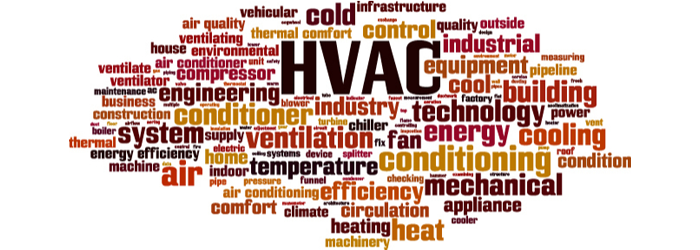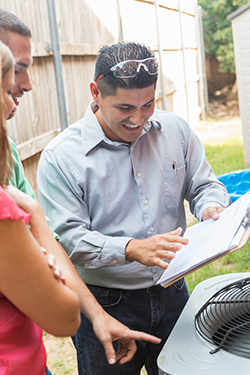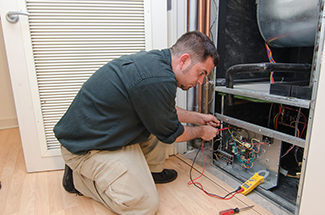A Day In the Life of an HVAC Installer & Technician
 12 October 2021
12 October 2021 

A Day In the Life of an HVAC Installer & Technician
When the temperature in our homes is comfortable, we tend to forget about the people who make our comfort possible. On that first cold morning when the winter chill arrives and the heat doesn’t kick on, we may find ourselves scrambling for an HVAC contractor.
The HVAC industry (heating, ventilation, and air conditioning) is divided between installation and technician work, with some professionals performing both. According to the industry group Advanced Energy Economy, half a million people in the U.S. are employed in the high-efficiency HVAC sector, with another 600,000 spending at least some of their time on the job working with high-efficiency HVAC equipment.
The difference between an installer and a technician.
When you call an HVAC company, either an installer or a technician will come to your home. There is a difference between HVAC installers and HVAC technicians, as explained by North American Trade Schools. HVAC installers are primarily responsible for installing new HVAC systems, and technicians focus on maintaining and repairing existing HVAC systems. Both require a good understanding of how HVAC systems work.
Installers tend to be more involved in the construction industry than technicians. When a new building is under construction, it is the HVAC installer who sets up the HVAC system. Whereas, technicians tend to work with home and business owners with an existing HVAC system that needs repairs or maintenance.
A day in the life of a residential HVAC professional.
Andrew Dobbins, owner, Intelligent Design Air Conditioning & Heating, a Rosie-Certified Partner, takes us through a typical day of one of his eight technicians and 10 installers.
The installers and the technicians arrive at the yard at 6:30 a.m. They clear their vehicles of the remnants from the previous day’s jobs and reload parts needed for the day. They use a checklist to ensure they have all the equipment they will need for the day.

Roughly an hour later, they are off to their first job of the day. Though, one day a week they attend either the installer or technician meeting before heading out.
When the installer arrives, they will introduce themselves to the homeowner and walk them through what the job will entail. The installer remains until the job is finished. Once the new unit is installed, the airflow is checked, and the thermostat installed. The homeowner is then taught how to use the thermostat. Before leaving, the installer will take pictures of the finished job and upload them to a service system so the install manager can review them. The manager will either authorize the completion of the project or instruct the installer to make adjustments.
For service calls, upon arriving and meeting with the homeowner, the technician will first assess what is wrong with the unit. Once the problem is identified, it is discussed with the homeowner, fixed, and the payment collected. Sometimes parts need to be ordered. The technician will return to finish the job and the collect any balance due. A technician generally goes on four to six calls a day in the peak season which runs April through September. Calls pick up in January and February for heating issues. Between those months, service technicians are performing routine maintenance and pre-heating checks.
The hours that HVAC technicians and installers keep tend to differ. HVAC installers are typically able to set their appointment schedules, pending the arrival of the crane and unit.
Technicians are servicing homes and businesses; therefore, their schedules need to accommodate those of their customers. Sometimes they need to be on-call.
“During the non-peak season, an installer can be done by noon or 6:00 p.m. It totally depends on the day,” says Dobbins. “Installers may not have a job for the day. If that’s the case, they can spend their day doing something with their family.”
It’s different for technicians. “When you are dealing with existing homes, there are always jobs to be had. We always plan that something will come up on a 30-year-old-house that we weren’t expecting,” he says.
Their work requires a lot of physical stamina. When the end of the day comes, especially in the summer, they are wiped out. Dobbins says his installers and technicians have gotten used to the physicality and the heat that comes with the job. "They do it for the lifestyle,” Dobbins says. “We pay really well.”
What it takes to be an HVAC installer or technician.
Being an HVAC technician is more than just using a screwdriver or switching out refrigerants. They must understand the mechanics of heating, cooling, and ventilation, which requires math, chemistry, and physics skills. Additionally, they must be computer savvy, detail orientated, manage their time efficiently, problem-solve on the spot and communicate well with their team and the customer.
Years of experience, knowledge, and skills go into the making of a reputable installer and technician. Dobbins notes that a new service technician will train from the ground up for three to six months plus another two months in full-service.
His new installers train for eight weeks before becoming a helper. It takes many years before they can become a lead installer.

“My top installers have 25 years of experience,” he says. They come to the table with a lot of knowledge to take care of customers’ needs while driving around in a rolling warehouse so they can handle whatever is diagnosed.”
The specific responsibilities associated with being an HVAC technician include:
- Performing preventive maintenance on equipment.
- Install new HVAC equipment.
- Identify equipment, systems repair, and replacement needs.
- Maintain and repair heating and cooling systems.
- Troubleshoot residential and light commercial equipment.
- Replace or repair defective parts.
- Identify equipment parts and components that are required to repair and maintain equipment.
- Perform all work following established safety procedures.
- Complete maintenance and repair records updates.
- Perform maintenance and service repairs on refrigeration, HVAC, and other equipment.
- Make service calls to customer homes and provide expert troubleshooting and repair service to a variety of equipment.
- Test each system after service/repair.
There is a lot of skill and knowledge that goes with being an HVAC installer or technician. HVAC repair and installation is not a DIY project. Always hire an HVAC contractor licensed by the Arizona Registrar of Contractors. When having your HVAC unit serviced, Dobbins suggests having a technician perform the following:
- Check thermostat settings.
- Check electrical connections and current voltage readings.
- Visually examine AC components and lubricate moving parts.
- Replace air filters.
- Remove debris from the area around your outdoor AC unit.
- Check the condensate drain for clogs and obstructions.
- Check refrigerant levels and top off the system, if necessary.
- Clean the evaporator and condenser coils.
Well, isn’t that cool!
Here’s a couple of HVAC Fun Facts:
- Movie theaters were among the first establishments to have air conditioning. It was a successful strategy to entice people to go to the movies in the summer. That is where the term “summer blockbuster” is derived.
- Mark your Rosie on the House Home Maintenance Calendar; June 22, 2022, is National HVAC Tech Day! This day is to honor the hard-working repairmen and women who keep us cool in the blazing heat. Treat your favorite HVAC technician or installer to a movie so they can escape the heat, too.
Podcast
It takes the first chill of an early fall to remind you it's time to get your heating system checked. Having a good relationship with your HVAC installer and technician is key. Tune-in! We discuss the different types of heating units, their required maintenance, and we find out the number one service call HVAC companies received in the past months. Plus, we talk about a Life Worth Living In Place topic regarding seniors and computers. Bonus: We share a "Cajun" trick to keep your toilet water from freezing!
###
Photo Credit
- Shutterstock
- Pixaby
Related Content
- DIY FAQ: Maintaining Your Heating And Cooling System
- Certified Partner: Intelligent Design Air Conditioning & Heating
- Certified Partner: Temperature Control, Inc.
- Certified Partner: Green Valley Cooling & Heating
- Certified Partner: Desert Sun Heating, Cooling & Refrigeration
- Certified Partner: Isley’s Home Service
- Certified Partner: REEIS
- Certified Partner: Integrity Heating & Cooling LLC
- Certified Partner: Knight Air Conditioning, Inc.
- Certified Partner: Pro Solutions Air Conditioning & Heating
- Certified Partner: Intermountain Plumbing & Mechanical
Print this page
recent post
- Duck, Duck, Duct! How Often Should Ductwork Be Cleaned?
- Vinyl vs. Fiberglass Windows: Which Is The Better Choice Of Replacement Window?
- We May Be The Grand Canyon State, But The Rocky Mountains Are Important For Arizona
- Welcome to Arizona! Things A Newbie to Arizona Should Know
- The Pros & Cons of Buying A Flipped House
- Getting In On The Ground Floor
- Why It’s More Critical Than Ever To Get Your AC Serviced Before Summer
- The Reality of Remodeling
- What To Look For When Comparing Your Roofing Quotes
- What To Expect When Buying New Windows & Doors
